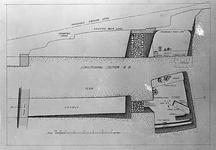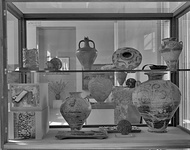| Title: | Tomb of the Ivory Pyxides | |
| Category: | Burial | |
| Description: | Mycenaean Chamber Tomb occupies a considerable part of the western half of section ΕΕ; lies about half way up the north slope of the Areopagus towards its eastern end, just below the highest point of the hill. The tomb consists of a roughly rectangular chamber approached from the north by a long dromos. it is entirely hewn out of the rock of the hill and except for the wall of rough stones that blocked the doorway, there is no masonry. The rock from which it is cut, is the greenish clayey shale which underlies most of the Agora area. The dromos has a preserved length of about eleven meters. It was originally several meters longer but its northern end was cut off by a late Roman retaining wall. For most of its length it is about two meters wide, but near the door of the chamber it widens slightly to about 2.40m. Its sides are not vertical, but slope slightly inward so that the highest preserved point the width is only about 1.50m. The floor of the dromos is not quite level but slopes very slightly downwards toward the chamber, being about 20 cm lower in front of the door, than it is at the outer end. The maximum preserved depth in front of the doorway is about 2.90m but originally it must have been a meter or two deeper, for the surface of bedrock has been considerably cut down here in modern and ancient times. The fill of the dromos was uniform throughout its length: soft clean greenish earth with pebbles and occasional small stones; few sherds. The only disturbances in this fill were three pits of the Turkish period near the north end. The door or entrance passage is narrower than the dromos (width ca. 1.20m and narrows very slightly to about 1.10m at the top; maximum height 2.40m). It is tunneled into the bedrock and has a slightly rounded roof which is nowhere very well preserved. Its outer or northern end was blocked by a neatly made dry wall of rough field stones. This wall was 1.40m thick and ran right up to the roof of the passage. It had obviously never been disturbed since the day it was built. When we removed the wall we were able to support the crumbly bedrock roof with plaster and iron rods. No objects of any sort were found either in or under the wall. The inner and southern end of the entrance passage was filed with fallen bedrock from its own roof and eat side. The chamber (max N-S dimension 4.30m, max E-W dimension 5.90m, max height 2.75m) is roughly rectangular in shape and is entirely hollowed out of the rock. It is not symmetrically set with the dromos, but it is set at a slight angle. Its sides are not straight, either vertically and horizontally; its angles are not right angles; Its corners are rounded. Its roof has entirely caved in, except for a small bit projecting at the north end of the west side; probably was not flat but slightly concave (all along the north side it seems that it rises from the sides toward the center). Across the east and west ends of the chamber there is a low rock-cut bench (average width 0.75m; average height 0.60m). There is only one grave cutting in the floor of the chamber, neatly placed in the SW corner (1.80m length; 0.60m width; 1.20m depth). Its cover slab, a piece of grayish slaty stone (1.90m length; 0.60m width; 0.15m thickness), lay on the floor beside it. The fill in and above the chamber had not been seriously disturbed since Mycenaean times. High above the chamber to the south, about five meters above its floor, is the remains of a wall of a late Roman house, part of which passed over the southwest corner of the chamber and had to be removed. About a meter below this, and again over the southwest quarter of the chamber, was a corner of light rubble wall of late hellenistic times. Neither of these walls disturbed the tomb proper in any way. Body and offerings were removed from the grave not long after they had been placed there (Mycenaean times); the chamber must had been entered by digging down from the top in the western half. | |
| Contents: | AS 1847: box containing envelopes of bone and ivory from various areas within tomb. Group of objects: a) on the east bench, a little north of its center (BI 511, P 15234-15239) b) on the floor in the northeast corner of the chamber just to the left of the door (B 704, P 15358-15359) c) on the floor of the chamber, about 0.40m from the south wall, near its mid-point (B 705, BI 513, BI 514, BI 530 d) on the floor in the northwest part of the chamber, at the foot of the bench about midway between the grave and the north wall of the chamber (J 64, J 65, J 68) | |
| Bibliography: | Hesperia 9 (1940), pp. 274-291, fig. 15. | |
| AJA XLII, 1939, pp. 578-586. | ||
| Agora VIII, p. 130. | ||
| Agora XIII, pp. 158-169, 274, pls. 29-33, 65, 67, 75, 77, 80. | ||
| Arch Anz, 1940, cols. 155ff. | ||
| ILN, July 22, 1939. | ||
| JHS LIX, 1939, pp. 189-190. | ||
| Chronology: | Myc. III A:1 | |
| Date: | May-June 1939 | |
| Section: | ΕΕ | |
| Grid: | ΔΔ:130/Ε | |
| References: | Publication: Agora VIII Publication: Agora XIII Publication: Hesperia 9 (1940) Publication Pages (8) Images (117) Objects (70) |
|
Show Everything (687,905) Publications (3,438) Reports (169) Letters (2,823) Places and Monuments (374) Plans and Drawings (14,400) Images (251,993) Objects (117,577) Sign in Provide feedback |
|


